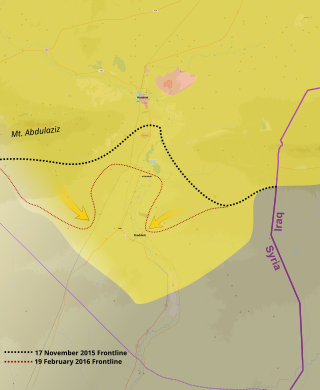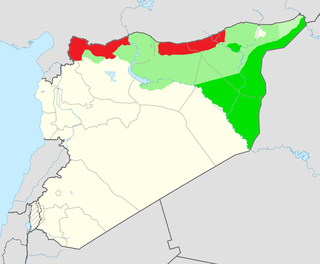The following is a timeline of the Syrian civil war from August to December 2014. Information about aggregated casualty counts is found at Casualties of the Syrian Civil War.
The Battle of Tabqa Airbase refers to a series of clashes between the Islamic State of Iraq and the Levant (ISIL) and the Syrian Arab Army in August 2014, during the Syrian Civil War. Tabqa was the last bastion for Syrian military forces in Raqqa province, which at the end of the battle came fully under the control of the ISIL.
The Battle of the Shaer gas field took place between the Islamic State of Iraq and the Levant (ISIL) and the Syrian government for the control over the Sha'er gas field during the Syrian Civil War. It is the second attack that was launched by ISIL on the gas field.

The Eastern al-Hasakah offensive was launched in the Al-Hasakah Governorate during the Syrian Civil War, by the Kurdish-majority People's Protection Units, Assyrian Christian militias, and allied Arab forces against the jihadist Islamic State of Iraq and the Levant, with the intent of retaking the areas of the Jazira Canton that had been captured by ISIL. Subsequently, the Syrian Armed Forces also launched an assault against the jihadists, without coordinating with the YPG.

The Battle of Sarrin refers to a military operation during 2015 in the northeastern Aleppo Governorate, during the Syrian Civil War, conducted by Kurdish YPG and allied forces against the Islamic State of Iraq and the Levant in the town of Sarrin, in an effort to capture the town and the surrounding region.

The Western al-Hasakah offensive, dubbed Operation Commander Rûbar Qamishlo by the Kurds, was a military operation during May 2015 in the Al-Hasakah Governorate, during the Syrian Civil War, conducted by Kurdish YPG and allied forces against the Islamic State of Iraq and the Levant. On 31 May 2015, as most of the offensive operations in the western Al-Hasakah Governorate ended, the part of the offensive in the Ras al-Ayn District expanded into the Tell Abyad region, in the northern Raqqa Governorate.

The Al-Hasakah city offensive was launched during the Syrian Civil War by the Islamic State of Iraq and the Levant against the city of Al-Hasakah, which was held by both the Syrian Armed Forces and the Kurdish YPG.

The Tell Abyad offensive or Martyr Rubar Qamışlo operation was a military operation that began in late May 2015 in the northern Raqqa Governorate, during the Syrian Civil War. It was conducted by the Kurdish-majority People's Protection Units (YPG) and the Free Syrian Army (FSA) against the Islamic State of Iraq and the Levant. The offensive took place from the end of May until July 2015. The campaign was the second phase of the Kurdish Operation Commander Rûbar Qamishlo, which began with the Al-Hasakah offensive, and involved the merger of the Kobanî offensive with the former. The focus of the campaign was to capture the key border town of Tell Abyad, and to link the Kobanî and Jazira Cantons in Northern Syria.

The 2015 Battle of al-Hasakah started as an offensive launched in the Al-Hasakah Governorate during the Syrian Civil War, in which the Islamic State of Iraq and the Levant (ISIL) attempted to capture the city of Al-Hasakah, which was divided into two areas held separately by the Syrian Armed Forces and the Kurdish People's Protection Units (YPG). On 17 July, YPG-led forces captured all of the roads and villages surrounding Al-Hasakah, fully besieging the ISIL militants remaining inside of the city. On 28 July, YPG forces and the Syrian Army expelled ISIL from most of Al-Hasakah, with two ISIL pockets persisting near the Al-Zuhour District and the southern entrance. On 1 August, the city was fully cleared of ISIL fighters.
The following is a timeline of the Syrian Civil War from January to July 2015. Information about aggregated casualty counts is found at Casualties of the Syrian Civil War.
The following is a timeline of the Syrian Civil War from January to July 2014. Information about aggregated casualty counts is found at Casualties of the Syrian Civil War.

The Syrian Democratic Forces (SDF) is a coalition formed by ethnic militias and rebel groups, and serves as the official military wing of the Autonomous Administration of North and East Syria (AANES). The SDF is allied to and supplied by the United States–led CJTF–OIR international alliance. Founded in 10 October 2015, the SDF claims that its mission is fighting to create a secular, democratic and federalised Syria. The SDF is opposed by Turkey, who claims the group has direct links to the PKK, which it recognizes as a terrorist group.
This article contains a timeline of events from January 2015 to December 2015 related to the Islamic State of Iraq and the Levant (ISIL/ISIS). This article contains information about events committed by or on behalf of the Islamic State, as well as events performed by groups who oppose them.

The al-Shaddadi offensive (2016), also known as Operation Wrath of Khabur, was an offensive launched by the Syrian Democratic Forces (SDF) during the Syrian Civil War, in February 2016. The main goal of this offensive was to capture the strategic city of Al-Shaddadi and the remainder of the southern al-Hasakah Governorate from the Islamic State of Iraq and the Levant (ISIL). During the offensive, the US-led coalition conducted more than 86 airstrikes in Al-Shaddadi and the nearby areas, in support of the SDF advances.
The Ithriyah-Raqqa offensive was a military operation launched in June 2016 by the Syrian Army with the stated goal of recapturing Raqqa, the capital of the Islamic State of Iraq and the Levant. The battle resulted in an Islamic State victory, after a series of counterattacks caused the Syrian Army to withdraw from the positions it had retaken in western Raqqa Governorate.

The Raqqa campaign was a military operation launched in November 2016 during the Rojava–Islamist conflict by the Syrian Democratic Forces (SDF) against the Islamic State of Iraq and the Levant (ISIL) in the Raqqa Governorate, with the goal of isolating and eventually capturing the Islamic State's capital city, Raqqa. The SDF's subsidiary goals included capturing the Tabqa Dam, the nearby city of al-Thawrah, and the Baath Dam further downstream. The campaign ended successfully in October 2017, with the capture of Raqqa.

Rojda Felat is a Syrian Kurdish senior commander of the Women's Protection Units (YPJ) and Syrian Democratic Forces (SDF), who has fought in the Rojava conflict since it began in 2012, and has led several major campaigns against the Islamic State of Iraq and the Levant (ISIL). A revolutionary feminist, Felat's stated goal is to achieve social transformation in the Middle East through the YPJ, "liberating the Kurdish woman and the Syrian woman in general from the ties and control of traditional society, as well as liberating the entirety of Syria from terrorism and tyranny".

The Battle of Tabqa was a Syrian Democratic Forces (SDF) military operation against the Islamic State of Iraq and the Levant (ISIL) to capture and secure the Tabqa Dam, al-Thawrah (al-Tabqah), Tabqa Airbase, and the surrounding countryside during the 2016–2017 Raqqa campaign of the larger Rojava-Islamist conflict of the Syrian civil war. The SDF assault began on 22 March 2017, and resulted in the capture of Tabqa and the Tabqa Dam on 10 May 2017. The SDF was supported by the United States-led CJTF–OIR coalition during the battle.
Opposition–ISIL conflict during the Syrian Civil War started after fighting erupted between Syrian opposition groups and the Islamic State of Iraq and the Levant (ISIL). In early January 2014, serious clashes between the groups erupted in the north of the country. Opposition groups near Aleppo attacked ISIL in two areas, Atarib and Anadan, which were both strongholds of the fundamentalist Sunni organization. Despite the conflict between ISIL and other rebels, one faction of ISIL has cooperated with the al-Nusra Front and the Green Battalion to combat Hezbollah in the Battle of Qalamoun. By 2018.

The Eastern Syria insurgency is an armed insurgency being waged by remnants of the Islamic State of Iraq and the Levant (ISIL) and both pro and anti-Syrian government Arab nationalist insurgents, against the Autonomous Administration of North and East Syria (AANES), its military, and their allies in the US-led Combined Joint Task Force – Operation Inherent Resolve (CJTF–OIR) coalition.












